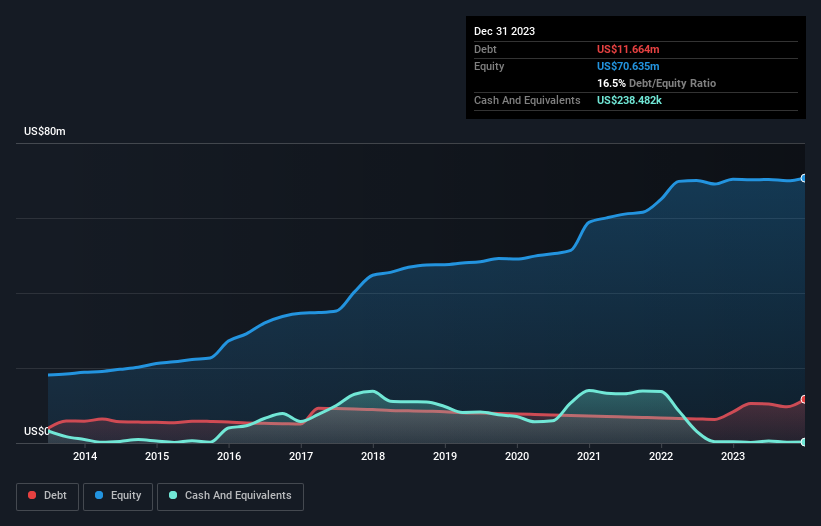- United States
- /
- Beverage
- /
- NasdaqCM:WVVI
Is Willamette Valley Vineyards (NASDAQ:WVVI) Weighed On By Its Debt Load?
Howard Marks put it nicely when he said that, rather than worrying about share price volatility, 'The possibility of permanent loss is the risk I worry about... and every practical investor I know worries about.' So it might be obvious that you need to consider debt, when you think about how risky any given stock is, because too much debt can sink a company. Importantly, Willamette Valley Vineyards, Inc. (NASDAQ:WVVI) does carry debt. But is this debt a concern to shareholders?
Why Does Debt Bring Risk?
Debt is a tool to help businesses grow, but if a business is incapable of paying off its lenders, then it exists at their mercy. Ultimately, if the company can't fulfill its legal obligations to repay debt, shareholders could walk away with nothing. While that is not too common, we often do see indebted companies permanently diluting shareholders because lenders force them to raise capital at a distressed price. Of course, debt can be an important tool in businesses, particularly capital heavy businesses. The first step when considering a company's debt levels is to consider its cash and debt together.
See our latest analysis for Willamette Valley Vineyards
What Is Willamette Valley Vineyards's Debt?
The image below, which you can click on for greater detail, shows that at December 2023 Willamette Valley Vineyards had debt of US$11.7m, up from US$8.31m in one year. On the flip side, it has US$238.5k in cash leading to net debt of about US$11.4m.

How Healthy Is Willamette Valley Vineyards' Balance Sheet?
According to the last reported balance sheet, Willamette Valley Vineyards had liabilities of US$13.8m due within 12 months, and liabilities of US$21.3m due beyond 12 months. On the other hand, it had cash of US$238.5k and US$3.12m worth of receivables due within a year. So it has liabilities totalling US$31.7m more than its cash and near-term receivables, combined.
Given this deficit is actually higher than the company's market capitalization of US$23.1m, we think shareholders really should watch Willamette Valley Vineyards's debt levels, like a parent watching their child ride a bike for the first time. In the scenario where the company had to clean up its balance sheet quickly, it seems likely shareholders would suffer extensive dilution. The balance sheet is clearly the area to focus on when you are analysing debt. But you can't view debt in total isolation; since Willamette Valley Vineyards will need earnings to service that debt. So if you're keen to discover more about its earnings, it might be worth checking out this graph of its long term earnings trend.
Over 12 months, Willamette Valley Vineyards reported revenue of US$39m, which is a gain of 15%, although it did not report any earnings before interest and tax. We usually like to see faster growth from unprofitable companies, but each to their own.
Caveat Emptor
Importantly, Willamette Valley Vineyards had an earnings before interest and tax (EBIT) loss over the last year. Indeed, it lost US$1.2m at the EBIT level. Considering that alongside the liabilities mentioned above make us nervous about the company. It would need to improve its operations quickly for us to be interested in it. Not least because it burned through US$6.7m in negative free cash flow over the last year. So suffice it to say we consider the stock to be risky. When analysing debt levels, the balance sheet is the obvious place to start. But ultimately, every company can contain risks that exist outside of the balance sheet. For instance, we've identified 2 warning signs for Willamette Valley Vineyards (1 can't be ignored) you should be aware of.
When all is said and done, sometimes its easier to focus on companies that don't even need debt. Readers can access a list of growth stocks with zero net debt 100% free, right now.
Valuation is complex, but we're here to simplify it.
Discover if Willamette Valley Vineyards might be undervalued or overvalued with our detailed analysis, featuring fair value estimates, potential risks, dividends, insider trades, and its financial condition.
Access Free AnalysisHave feedback on this article? Concerned about the content? Get in touch with us directly. Alternatively, email editorial-team (at) simplywallst.com.
This article by Simply Wall St is general in nature. We provide commentary based on historical data and analyst forecasts only using an unbiased methodology and our articles are not intended to be financial advice. It does not constitute a recommendation to buy or sell any stock, and does not take account of your objectives, or your financial situation. We aim to bring you long-term focused analysis driven by fundamental data. Note that our analysis may not factor in the latest price-sensitive company announcements or qualitative material. Simply Wall St has no position in any stocks mentioned.
About NasdaqCM:WVVI
Willamette Valley Vineyards
Produces and sells wine in the United States and internationally.
Mediocre balance sheet and slightly overvalued.
Similar Companies
Market Insights
Community Narratives


Recently Updated Narratives


The Quiet Giant That Became AI’s Power Grid


Nova Ljubljanska Banka d.d will expect a 11.2% revenue boost driving future growth



